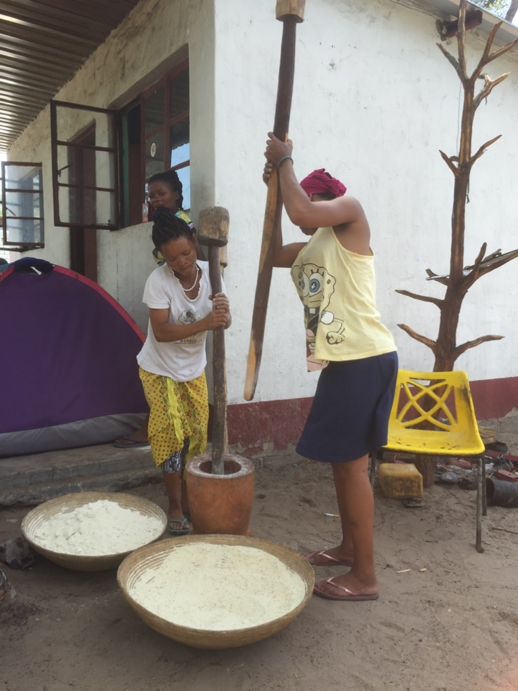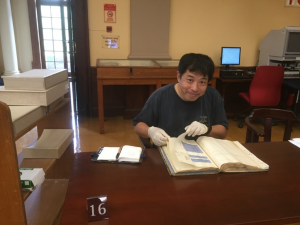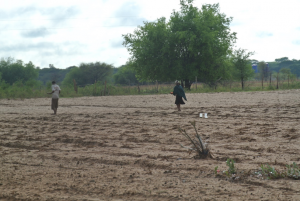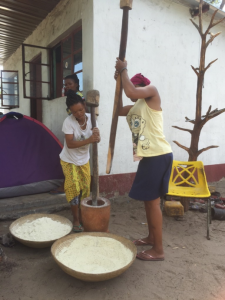
South Africa/Namibia Report
With a Focus on Cape Town University and Ohangwena Region
Kyoto University Graduate School
Associate Professor of Asian and African Area Studies
Akira Takada
From Dec. 17, 2015 to Jan. 6, 2016, I visited South Africa’s Cape Town University and the Ohangwena Region in Namibia. I collected materials and participated in research meetings for this project’s planning and management.
At Cape Town University, I met with my counterparts for this research project from the University of Cape Town’s Centre for African Language Diversity (CALDi), director Matthias Brenzinger and postdoctoral fellow Sheena Sha. We held meetings to discuss paradigm shifts in research on Africa due to globalization (Pic. 1).
Pic. 1 Dr. Matthias Brenzinger (right) and Postdoctoral Fellow Sheena Sha, standing next to CALDi’s official vehicle.
Cape Town University is one of Africa’s most prominent research and higher-education institutions. The university has produced top-level professionals representative of Africa in diverse fields, such as academics, business, and politics. In addition, it possesses valuable and important research materials for advancing the project in question. In particular, its large-scale preservation of the materials collected by Willhelm Bleek (1827–75), a pioneering researcher of the language and folklore of the San people, deserves special mention (Pic. 2).
Pic. 2 The author perusing the materials collected by Willhelm Bleek (1827–75) in the University of Cape Town archives.
CALDi’s Dr. Matthias Brenzinger is a noted linguist of the Khoisan languages. His literature research using these materials, as well as his studies on the physical and verbal communication of the Khwe-Ani and Khomani in South Africa, have advanced the field. The focus of our research meetings was the requirements for accepting young researchers from Kyoto University scheduled to go to Cape Town University, and expectations regarding their activities there; and the requirements for acceptance, and expectations for, researchers from Cape Town University by Kyoto University. We discussed concrete proposals and ways to regulate these exchanges. Cape Town University has a wide variety of courses and academic departments focused on Africa that regularly conduct all sorts of seminars and symposiums related to linguistics, anthropology, and area studies. I am confident that the participation of both young and senior researchers from Kyoto University in these endeavors would constitute an incredibly valuable academic exchange.
Moving on to my visit to Namibia, I visited the Ohangwena Region of north-central Namibia, an important component of the collaborative research project with Dr. Brenzinger and others, where I collected research materials on the paradigm shift in research in African studies. The north-central part of Namibia is the center of the Ovambo people, who make up the majority of the country and whose primary livelihood is agriculture and stock-farming. However, the earliest settlers in the area were the San, a hunter-gatherer people. Later, a diverse group of peoples and organizations came to the area; this included the Ovambo and European missionaries, beginning with those from Finland. The San have a long history of unique interactions with these diverse actors (Pics. 3, 4).
Pic. 3 Land first cultivated by a religious mission and currently a vast farm administered by the government. San people sowing pearl millet.
Pic. 4 Young San women grinding harvested pearl millet using mortar and pestle.
However, early research into the San stemmed from the fact that researchers wished to understand the way of life of a people who were purely hunter-gatherers. This led them to the San, who had received little influence from the outside world. As a result, there was almost no focus on the distinct characteristics of the San of north-central Namibia. Therefore, by examining existing research on the San and their complicated relationship with various actors, we hope to reconsider the scholarship related to the San’s language, culture, and livelihood. We believe that this study, in turn, will contribute to changing the traditional paradigm of research in Africa. We plan to carry out this project with researchers from Kyoto University, which has been engaged in research on the San for half a century; researchers from Cape Town University, the central hub for linguistic, literary, and action research on the San; and on-site collaboration with a wide variety of organizations that provide on-field support to the San.













